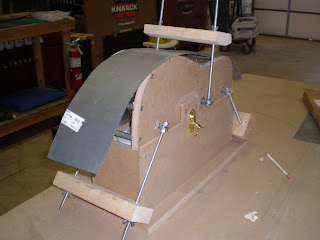Working on a late 19th or early twentieth century bowlback mandolin built by Joseph Bohmann.
From Harpguitars.net, "Little is known of Bohmann’s career, and much of it is conflicting. It is thought by many that he was one of the first, if not the first, to build mandolins in America, or at least, Chicago. These were the Neapolitan-style bowlback mandolins, which Bohmann made in many grades. Most examples known today are rather pedestrian, but high-end and “presentation” Bohmann mandolins and guitars also exist. Michael Wright states that Bohmann was an early mandolin supplier for both Wards and Sears (1894). As is the case with nearly every Chicago musical instrument maker, there are rumors and clues about the Larson brothers building instruments for Bohmann, but so far, nothing conclusive.
According to Wright, Bohmann “was born in Neumarkt (Bohemia), Czechoslovakia in 1848. He later emigrated to America, and then founded Bohmann´s American Musical Industry in 1878.” Wright gives Bohmann’s instrument building dates as “1878 to the late 1920s,” while Michael Holmes of Mugwumps gives 1876-1930. Regardless, it’s unclear exactly when Bohmann died, or what happened to the business when he did. He would have been 68 when the last patent was issued in 1916 – a ripe old age for a guitar maker at that time.
Even more unclear is the fate of the factory and instruments after Bohmann’s death. Stories abound from many different sources, but the facts are inconsistent. Apparently, the building was locked up for forty or so years! Eventually, in the ‘70s or ‘80s (again, unclear), the factory was opened by the inheritors – by some accounts, a Bohmann grandson. There are tales of instruments “discovered in the attic of the old factory building in Chicago where (Bohmann) had his shop…several instruments in completed and near completed stages, wrapped up in World War II newspapers.”
The following photo shows the back wood staves. These appear to be maple, are beautiful, and in great shape.
The top is where the problem lies. It is cracked and sunken in right at the bend where the bridge sits.
After the top is removed you can see the label and the interior in good shape. A few pieces of binding need to be replaced.
Hopefully the bracing can be reused. The tortoise pick guard does not seem to be salvageable.
The fretboard is in pretty good shape, a little dry with a small crack that should not affect anything.
Tuners and headstock back metal cover are in good shape and work. Note the stamp on the metal plate.
With a little luck and a lot of patience I think this will play again.































